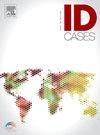Nail the diagnosis: Lamivudine-induced periungual pyogenic granulomas in PLHIV
IF 1.1
Q4 INFECTIOUS DISEASES
引用次数: 0
Abstract
Background
Pyogenic granuloma (PG), also known as lobular capillary haemangioma, is a benign vascular proliferation that typically presents as friable, red, pedunculated papules on the skin or mucous membranes. Multiple periungual pyogenic granulomas, a unique entity within cutaneous pyogenic granulomas, most frequently occur in association with medications, including antiretroviral drugs.
Clinical case
A 30-year-old male living with HIV presented with painful, progressively enlarging ulcero-proliferative lesions on the fingertips and toes, occurring 12 months after initiating highly active antiretroviral therapy (HAART) comprising Tenofovir disoproxil (300 mg), Lamivudine (300 mg), and Dolutegravir (50 mg). Examination revealed haemorrhagic, friable granulation tissue over the nail folds and paronychial areas of multiple digits. Systemic examination was unremarkable. Differential diagnoses included drug-induced PG, bacillary angiomatosis, Kaposi sarcoma, and cutaneous angiosarcoma. A biopsy confirmed the diagnosis of PG. Bartonella serology and tissue polymerase chain reaction (PCR) were negative, ruling out bacillary angiomatosis. Histopathology showed no features suggestive of Kaposi sarcoma or angiosarcoma. Among ART agents, lamivudine and indinavir have been most frequently associated with periungual PGs. The patient showed minimal improvement with topical corticosteroids, antibiotics, and debridement. Lamivudine was subsequently discontinued and ART was modified, leading to near-complete resolution of lesions over six months—supporting a diagnosis of lamivudine-induced periungual PG.
Conclusion
Periungual pyogenic granulomas can lead to significant discomfort and functional impairment. This case highlights the potential role of lamivudine as a causative agent and underscores the importance of ART modification in the effective management of drug-induced PG.
明确诊断:拉米夫定诱导的PLHIV患者舌苔周化脓性肉芽肿
化脓性肉芽肿(PG),也称为小叶毛细血管瘤,是一种良性血管增生,典型表现为皮肤或粘膜上易碎的红色带梗丘疹。多发性甲周化脓性肉芽肿是皮肤化脓性肉芽肿中的一种独特的实体,最常发生与药物有关,包括抗逆转录病毒药物。临床病例:一名30岁男性HIV感染者,在开始高效抗逆转录病毒治疗(HAART) 12个月后,指尖和脚趾出现疼痛,溃疡增生性病变逐渐扩大,包括替诺福韦二oproxil(300 mg),拉米夫定(300 mg)和多替格拉韦(50 mg)。检查显示出血,脆弱的肉芽组织在甲襞和多指甲状旁区。全身检查无明显异常。鉴别诊断包括药物性PG、细菌性血管瘤病、卡波西肉瘤和皮肤血管肉瘤。活检证实PG,巴尔通体血清学和组织聚合酶链反应(PCR)阴性,排除细菌性血管瘤病。组织病理学未见卡波西肉瘤或血管肉瘤的征象。在抗逆转录病毒治疗药物中,拉米夫定和茚地那韦最常与腹周PGs相关。局部皮质类固醇、抗生素和清创治疗对患者的改善甚微。随后停用拉米夫定,并改良抗逆转录病毒治疗,6个月后病变几乎完全消退,支持拉米夫定诱导的甲周炎的诊断。结论甲周化脓性肉芽肿可导致明显的不适和功能损害。该病例强调了拉米夫定作为一种病原体的潜在作用,并强调了抗逆转录病毒治疗在有效治疗药物性PG中的重要性。
本文章由计算机程序翻译,如有差异,请以英文原文为准。
求助全文
约1分钟内获得全文
求助全文

 求助内容:
求助内容: 应助结果提醒方式:
应助结果提醒方式:


